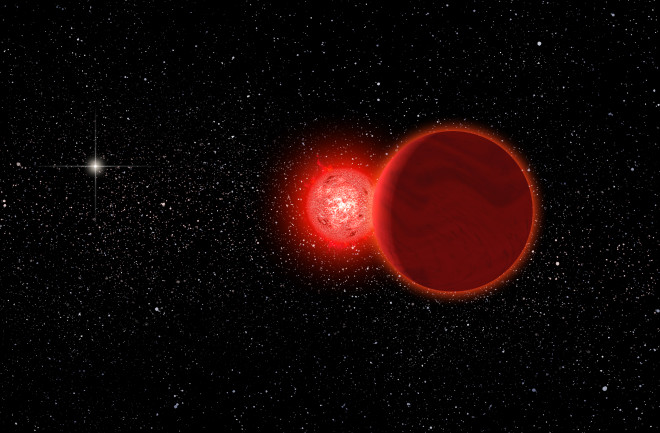It is quite remarkable how frequently wandering stars come close to our solar system.
The sun has experienced near encounters with other stars previously, and it is on track for a potentially hazardous close encounter in the near future.

Approximately every 50,000 years, a wandering star comes close to our solar system. While most of these stars pass by without causing any issues, occasionally one will come close enough to become a prominent feature in Earth’s night sky and disrupt the orbits of distant comets. One such star is Scholz’s Star, a binary system discovered in 2013. Its trajectory suggests that around 70,000 years ago, it traveled through the Oort Cloud, a region of icy bodies on the outskirts of our solar system. Some astronomers speculate that Scholz’s Star may have influenced the movement of these objects when it passed through.
Despite being relatively small and fast-moving, Scholz’s Star was not the only star to have a close encounter with our solar system. Recent research indicates that such events are more common than previously thought. This suggests that there may be more massive stars that have passed through, potentially causing greater effects. According to astronomer Eric Mamajek of NASA’s Jet Propulsion Laboratory, who brought attention to Scholz’s Star in a 2015 paper, we can expect more of these encounters in the future.
The Discovery of ‘Scholz’s Star’
Around the time of Christmas in 2013, Mamajek paid a visit to his friend and fellow astronomer, Valentin Ivanov, at the European Southern Observatory in Santiago, Chile. While engaging in conversation, Ivanov was examining recent observations of a star known as WISE J072003.20–084651.2.
The star piqued Mamajek’s curiosity due to its proximity of approximately 20 light-years, despite going unnoticed by astronomers because of its faint appearance and minimal apparent movement across the night sky.
To Mamajek, these characteristics served as a hint. Given its limited lateral movement, the star was likely moving either towards or away from us at a remarkable speed. As the astronomers conversed further, Ivanov calculated the star’s radial velocity to determine its rate of approach or recession from our sun. Before long, they obtained their answer.
“In a matter of five or 10 minutes, we obtained preliminary results indicating that this object came within a parsec [3.26 light-years] of the sun,” Mamajek explains. “It was swiftly traversing the solar neighborhood.”
Ultimately, Mamajek and Ivanov, along with their colleagues, would demonstrate that the star had passed even closer than initially thought. In fact, it had come closer to our sun than any other known star. This discovery led them to name the interstellar intruder after its original discoverer, an astronomer named Ralf-Dieter Scholz, who had dedicated considerable effort to locating nearby stars.
All the Other Passing Suns
Mamajek has moved on from studying Scholz’s Star. Meanwhile, other astronomers have taken up the task. Thanks to the European Space Agency satellite Gaia, which is designed to map the precise locations and movements of over a billion stars, we now have knowledge of other close encounters.
In 2018, a group of researchers led by Coryn Bailer-Jones of the Max Planck Institute for Astronomy in Germany utilized Gaia data to predict our sun’s future encounters with other stars. They identified nearly 700 stars that will pass within 15 light-years of our solar system in the next 15 million years. The team suggests that the majority of close encounters are yet to be discovered, but they estimate that around 20 stars will pass within a couple of light-years of us every million years.
“Space is vast,” Mamajek emphasizes. “Statistically, most of those stars would pass the outer edge of our solar system.” This implies that encounters similar to the one with Scholz’s Star are common, but only a few are close enough to potentially dislodge a significant number of comets, leading to a cosmic bombardment of Earth.
Nevertheless, a few stars are expected to come remarkably close. If a large, slow-moving star were to pass through the edge of the Oort Cloud, it could significantly disrupt the solar system.
The ‘Strongest Disrupting Encounter’ in History
The Gaia data from a 2016 study predict that in 1.4 million years, a massive star will pass through the outer solar system. This star, Gliese 710, will come within 10,000 astronomical units of our sun, which is well within the Oort Cloud. With half the mass of the sun, Gliese 710 is significantly larger than Scholz’s Star, which is only 15 percent of the sun’s mass. This size difference means that Gliese 710’s immense gravity could potentially disrupt the orbits of icy bodies in the Oort Cloud. Unlike Scholz’s Star, which would have been barely visible in the night sky, Gliese 710 is larger than our current closest neighbor, Proxima Centauri. When Gliese 710 reaches its closest point to Earth, it will shine as a brilliant orange orb, outshining all other stars in our night sky.
The authors of the paper published in the journal Astronomy & Astrophysics described this event as potentially the most significant disruptive encounter in the future and history of the solar system. Luckily, the inner solar system is a small area, so even if Gliese 710 sends comets towards us, it would still take millions of years for these icy bodies to reach Earth. This long timeframe should provide ample opportunity for any future humans to prepare and take necessary action. In the meantime, they can observe what might be one of the nearest stellar flybys ever recorded in the solar system.
Do not forget to share your opinion with us to provide you with the best posts !



0 Comments